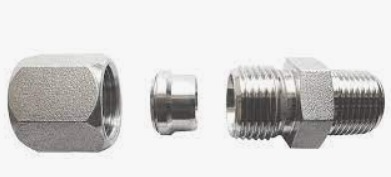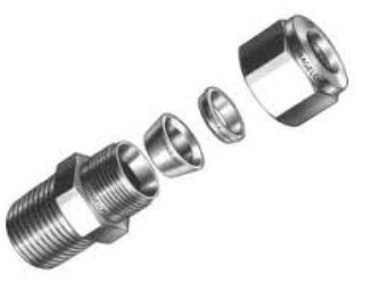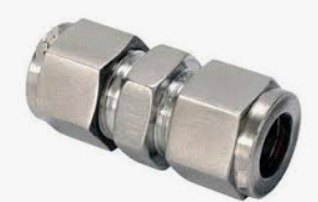In the realm of fluid systems, ferrule fittings stand as the unsung heroes, providing secure and reliable connections in various industries. From hydraulic systems to plumbing solutions, understanding the different types of ferrule fittings is essential for ensuring leak-free and efficient operations.
In this article, we will delve into the diverse universe of ferrule fittings, exploring their types, applications, and benefits.
What Are The Different Types of Ferrules?
Compression Ferrule Fittings:
Single Ferrule Compression Tube Fitting
Compression ferrule fittings are widely used in plumbing applications. They consist of a compression nut and a ferrule, creating a tight seal by compressing the ferrule against the tubing. These fittings are popular for their ease of installation and versatility in connecting different pipe materials.
Swage Ferrule Fittings:
Swage ferrule fittings, also known as crimp fittings, are prevalent in hydraulic systems. They involve crimping the ferrule onto the hose with a specialized crimping tool, ensuring a robust and leak-free connection. Swage fittings are favored for high-pressure applications, providing superior strength and durability.
Push-to-Connect Ferrule Fittings:
Push-to-connect ferrule fittings are revolutionizing the fluid connection industry. They allow quick and tool-free assembly by simply pushing the tubing into the fitting, creating a secure and reliable connection. These fittings are ideal for applications where rapid installation and disassembly are necessary.
Double Ferrule Fittings:
Double ferrule fittings, also known as twin ferrule fittings, feature two ferrules that secure the tubing to the fitting body. The front ferrule creates a seal against the fitting body, while the back ferrule provides additional support. These fittings offer excellent resistance to vibration and thermal cycling, making them suitable for challenging environments.
Advantages of Ferrule Fittings: Why Choose Ferrule Connections?
Ferrule fittings offer a plethora of advantages, making them a preferred choice in various industries:
Leak-Free Connections: Ferrule fittings create tight seals, preventing leaks and ensuring the integrity of fluid systems.
High Pressure and Temperature Resistance: Ferrule fittings excel in high-pressure and high-temperature applications, maintaining their performance under extreme conditions.
Easy Installation: Different types of ferrule fittings offer user-friendly installation methods, saving time and labor costs during assembly.
Versatility: Ferrule fittings are compatible with a wide range of materials, including stainless steel, brass, and plastic, enhancing their versatility in diverse applications.
Ferrule Fittings in Action: Real-World Applications
Ferrule fittings find applications across various industries, including:
Hydraulic Systems: In hydraulic systems, ferrule fittings ensure reliable connections in critical components like pumps, valves, and hoses.
Oil and Gas Industry: Ferrule fittings are vital in oil and gas processing plants, connecting pipelines and ensuring the efficient flow of fluids.
Pharmaceutical Sector: The pharmaceutical industry relies on ferrule fittings for sanitary connections, maintaining the purity of processes and products.
Food and Beverage Industry: Ferrule fittings are used in food and beverage processing, providing hygienic connections that meet industry standards.
Frequently Asked Questions (FAQs)
What is the primary difference between compression and swage ferrule fittings?
Compression ferrule fittings create a seal by compressing the ferrule against the tubing, while swage ferrule fittings involve crimping the ferrule onto the hose for a secure connection. Swage fittings are preferred for high-pressure applications.
Can push-to-connect ferrule fittings be reused after disassembly?
Push-to-connect ferrule fittings are designed for single-use applications. Once disconnected, they may not provide the same level of sealing integrity upon reassembly.
Are ferrule fittings compatible with plastic tubing?
Yes, ferrule fittings come in designs suitable for plastic tubing, ensuring reliable connections in various industries, including pneumatic systems and water treatment.
How do double ferrule fittings resist vibration and thermal cycling?
Double ferrule fittings have a unique design where the back ferrule provides additional support, enhancing the fitting’s resistance to vibration and thermal cycling, making them ideal for challenging environments.
Can ferrule fittings be used in corrosive environments?
Yes, ferrule fittings are available in corrosion-resistant materials such as stainless steel, making them suitable for use in corrosive environments in chemical processing plants and marine applications.
Are ferrule fittings compatible with high-viscosity fluids?
Ferrule fittings can handle a wide range of fluids, including high-viscosity substances. Proper selection of materials and fitting design ensures compatibility with different fluid types.
Conclusion: Harnessing the Power of Ferrule Fittings
Ferrule fittings epitomize innovation and reliability in fluid connection solutions. Their diverse types, applications, and advantages make them indispensable in various industries, ensuring seamless operations and enhanced efficiency.
By understanding the different types of ferrule fittings and their real-world applications, industries can make informed decisions, choosing the right fittings for their specific needs.
Post time: Dec-08-2023




